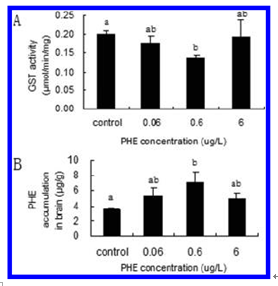Sun LB, ZH Zuo, HM Luo, M Chen, YF Zhong, YX Chen and CG Wang.Environmental Science & Technology, 2011. 45: 10212-10218.
Phenanthrene (PHE) is one of the most abundant polycyclic aromatic hydrocarbons in the aquatic environment. This study was conducted to investigate the effects of PHE at environmentally relevant concentrations on testicular development in maleSebastiscus marmoratus. After 50 days exposure, the gonadosomatic indices and percentage of sperm produced showed a U-shaped dose response. The levels of salmon-type gonadotropin releasing hormone, follicle-stimulating hormone, luteinizing hormone mRNA, 17β-estradiol, andγ-glutamyl transpeptidase activity all showed a U-shaped dose response, which clearly demonstrated the U-shaped effects of PHE exposure on spermatogenesis and also elucidated the action pathway. This result would bring a difficulty and a challenge to any risk assessment of PHE exposure to the reproductive health of fishes. Thus far, there has been no ready explanation for a U-shaped dose_response curve, which is well recognized as a hormetic phenomenon for many hormones, drugs, and toxic compounds. In the present study, PHE accumulation in the brain showed an inverse U-shaped increase compared to the control. Glutathione S-transferase activity in the brain showed a U-shaped dose-response, which was related with the PHE accumulation. These results have given a reasonable explanation for the U-shaped dose-response via alteration of biotransformation enzyme activity in the brain.

Figure. 5 Inhibition of GST activities (A) of brain showed a U-shaped dose-response, while phenanthrene (PHE) accumulation in the brain (B) showed an inverse U-shaped dose-response inSebastiscus marmoratusexposed to PHE for 50 days. Data are presented as means(SE (n=6). p < 0.05 vs the control as assessed using one-way anova with the tukey’s test (for gst activity) or the duncan test (for phe accumulation).

